Buildings that absorb pollution
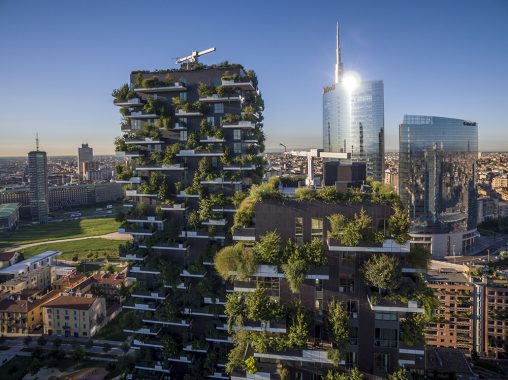
Parks were first created to offer much-needed green spaces and absorb city pollution. As the world’s urban centres grow ever larger and space is at a premium, we need to come up with new solutions to a growing smog and air quality problem.
Nature maintains a balance between organisms and events that produce carbon dioxide and those that absorb it and other potentially harmful gasses. Man has disrupted this balance since the onset of the machine age and the spread of urban centres first began some two centuries ago. Today the spread has become a sprawl and entire regions are covered in concrete, steel, tarmac and glass, with barely a leaf or blade of grass in place. As a result, temperature extremes, heat currents and smog are becoming part of life in large urban areas.
The World Health Organisation (WHO) of the UN estimates that 80 per cent of city dwellers breathe polluted air every day. In Italy alone, this causes almost 90,000 deaths a year due to respiratory and cardiovascular illnesses. If we don’t want to walk around with masks on our faces, as they do in the Far East, we need to find some clever solutions to the problem fast. Fortunately there are people doing just that, and they come from a wide range of disciplines, including science, medicine and engineering – not to mention architecture. Here are some useful smog-beating architectural creations for the immediate future.
Palazzo Italia (Milan)
Milan has been one of the most polluted cities in Europe since the 1970s. Earlier attempts to reduce traffic have largely failed and so the city’s air quality continues to diminish. Cement doesn’t have a very good reputation as it is more or less synonymous with urban sprawl and the destruction of natural habitats, but German multinational HeidelbergCement proves that it can also be part of the solution.
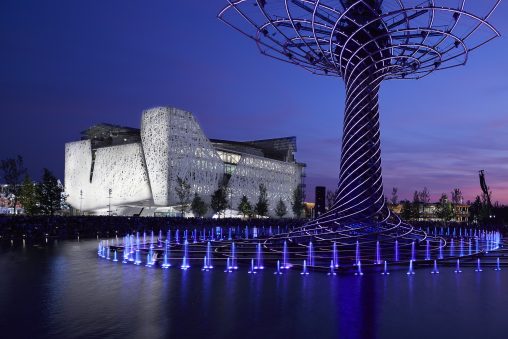
They have developed photocatalytic cement – a new kind of ‘smart cement’ that absorbs pollutants in the air and processes them within to convert these potentially harmful particles into harmless salts. In this way, a surface of 9,000 square metres of this material can absorb the exhaust gasses emitted by 100 diesel cars and almost 300 petrol engines. The Italian pavilion at the 2015 Expo in Milan became a showcase for this new material.
Dubbed the Palazzo Italia, this huge structure designed by architects Nemesi & Partners and built by Italiana Costruzione, was at the heart of the event at which 148 nations from around the world were represented. 35 metres tall, this was an ambitious project whose elegant white-tones and web-like structure produced by Italcementi, which is part of the HeidelbergCement group, is made up of prefabricated cement built sections that feature a special pollutant absorbing mortar. For a city such as Milan as well as others across the world, this is an attractive way of cleaning up the air.
Hospital Manuel Gea Gonzalez (Mexico City)
If smog is a problem in Milan it is an everyday curse in Mexico City, a vast sprawling metropolis of over 20 million people. The Mexican capital is one of the cities most in need of an improvement in air quality, and edifices such as the Hospital Manuel Gea Gonzalez, designed by Elegant Embellishments, is a great example of how it can be done. Once again, the solution appears to lie in a honeycomb façade that not only looks good but has the ability to filter air pollutants as well as provide important protection from solar glare and overheating – thus reducing the need for air conditioning and in the process improving energy and cost-efficiency.
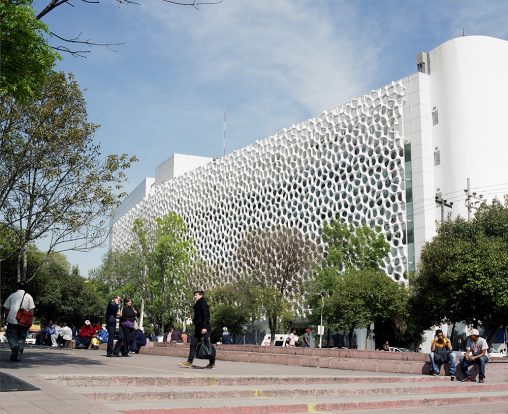
In this case the particle filtering is done by a coating of superfine titanium oxide, which in combination with daylight absorbs and neutralises car emissions and other toxins. The new technology is called Prosolve370e and has the capacity to cancel out the emission from 1,000 cars per day. We’re in need of many, many more buildings such as this, especially in places like Mexico City, but this hospital leads the way in offering intelligent ways forward.
Bosco Verticale (Milan)
The architects Stefano Boeri have opted for a natural solution, incorporating trees and plants into their design for a high-rise in the northern Italian city of Milan. Not only does all the greenery hanging off the balconies absorb carbon dioxide, convert it into oxygen and then release the latter into the surrounding city air, but it also looks great in a landscape of hard, impersonal materials such as steel, concrete, stone and glass.

Like a vertical park rising into the air, Bosco Verticale is just that, a much-needed reference to nature that soothes the soul as much as the eye and makes the urban environment less harsh and more welcoming. Fighting pollution is not just about reducing harmful particles in the air – it is also about making the urban world that most of us inhabit a more harmonious, pleasant, safe and if possible beautiful place, for these elements also improve wellbeing and social cohesion.
This “world’s first vertical forest” consists of two towers clad in the greenery of 21,000 plants, and in so doing adds almost 2.5 acres of ‘high-rise park’ area to the city’s urban landscape. Not only does it convert carbon dioxide into oxygen, but it also reduces the urban heat island effect and dampens traffic noise. You simply can’t beat nature!
Green 25 (Turin)
The Italians have taken this issue to heart, for the next project is located in Turin, otherwise known for Juventus and its car factories. Green 25, as it is called, is a design by Luciano Pía that offers an otherworldly aspect to the urban landscape. From the outside this residential apartment complex seems like one of those old mansions forgotten by time and taken over by creepers and weeds, but in reality it was completed in 2012 and is ‘overgrown’ with greenery by design.
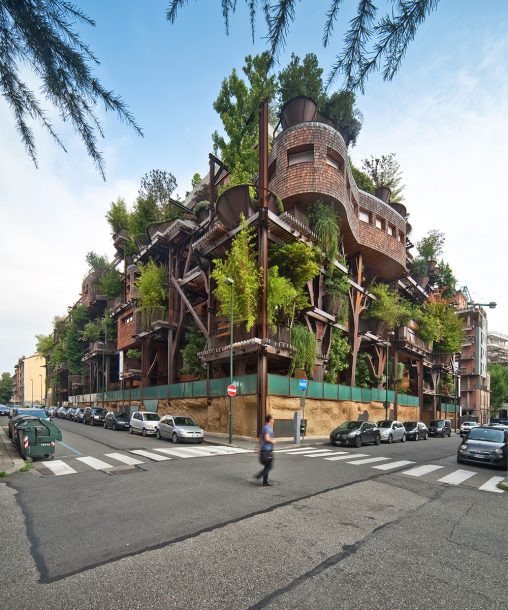
To begin with, the structure isn’t flat or symmetrical but offers a rather intricate combination of irregular shapes. This, in turn, leads to the creation of intimate pathways, terraces and inner squares, all of which are planted with trees and shrubs. The same is true of the balconies, giving Green 25 the look and feel of apartments set within a lush forest. There is so much foliage embracing the complex that even the steel structure is barely visible, with the roof surfaces also carpeted in greenery that absorbs pollution just as it provides a cosseting, cosy and private living environment.
The design has a village-like feel that promotes a sense of identity and community within the apartment complex that few of its rather more sterile brethren can emulate, and of course there is technology to aid the fantastic work done by the lovely plants and shrubs. The latter act as a screen between the homes and the city, drowning out city noise, creating a microclimate, reducing temperature and moisture extremes, and once again soothing the soul as they reflect the natural seasons in cities that have long forgotten what that looks and feels like.
In addition to this, continuous insulation, sun glare protection, geothermal heating and cooling and rainwater recycling for irrigation make the 63 apartments in the complex unique and environmentally sound. Together, the trees and plants absorb 200,000 litres of carbon dioxide and produce 150,000 litres of oxygen per hour.
Smog Free Tower (Eindhoven)
Daan Roosegaarde from The Netherlands has come up with a slightly different solution to the problem of urban air quality. His proposal features a seven-metre tall smog-absorbing tower that uses patented positive ionisation technology to clean up ambient air in public spaces. Endowed with the capacity to clear 30,000 cubic metres of air per hour, it is an ideal ground level solution and one particularly useful for crowded areas where pedestrians have to share space with cars.
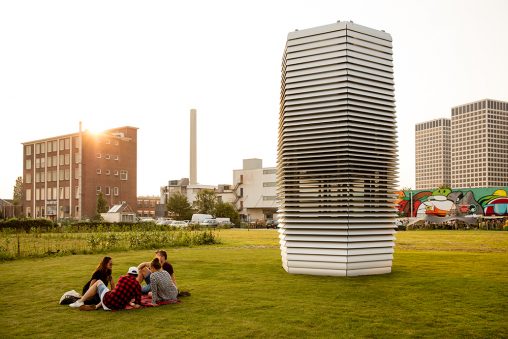
One could imagine them standing alongside the main avenues of cities like New York, Shanghai and São Paulo, to name a few, and before long this could be a feature of most squares across modern urban centres. The structure is modern and attractively styled, fitted with the latest green technology and should be out there as the kind of public amenity for the 21st century.
City Tree (Berlin)
As their name suggests, Green City Solutions is a Berlin-based studio that is serious about solving the challenges posed by large urban centres and mass transport systems. Their concept involves a ‘smog-eating’ tree sculpture that is as effective as 275 trees in inhaling not only carbon dioxide but also nitrogen oxide and fine dust particles. The structure is made of a concrete that sucks in these elements from the surrounding air, purifies it and ‘exhales’ it again.
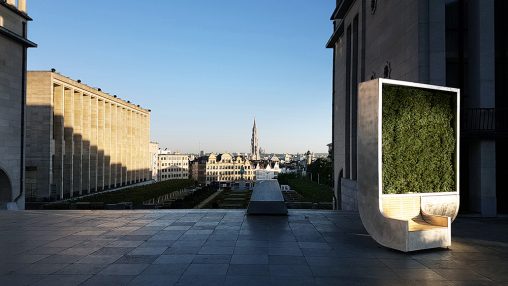
This is done by bacteria inhabiting the moss plants within the tree, which convert inorganic pollutants into biomass at a rate of 275 normal trees whilst requiring far less space to do so. The City Tree is another of the growing number of exciting new solutions that, if adopted on a large scale, have every potential of making our air quality breathable again while in the process beautifying the places we live and work in.
First published in Essential Magazine.












